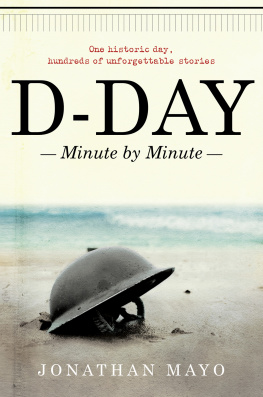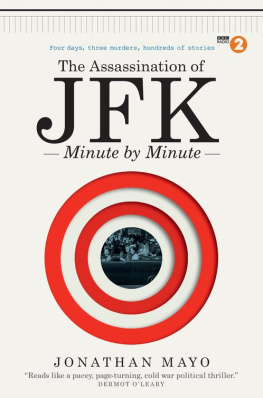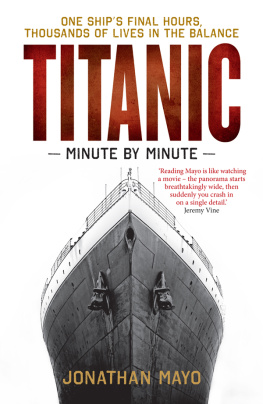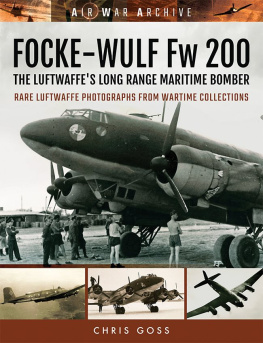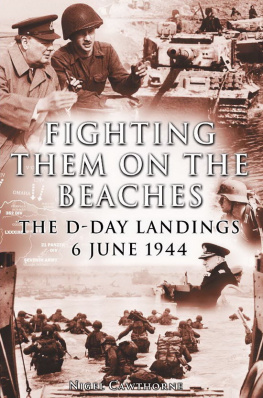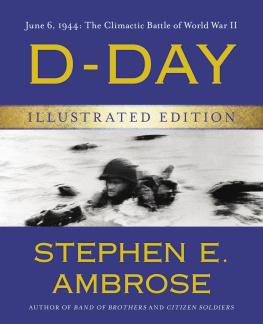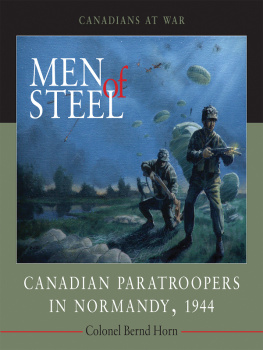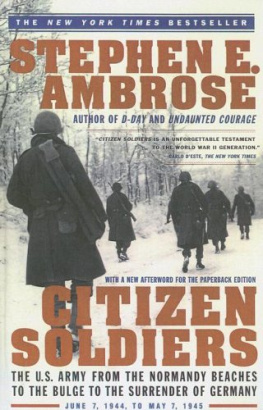Thank you for downloading this Atria Books eBook.
Join our mailing list and get updates on new releases, deals, bonus content and other great books from Atria Books and Simon & Schuster.
C LICK H ERE T O S IGN U P
or visit us online to sign up at
eBookNews.SimonandSchuster.com
We hope you enjoyed reading this Atria Books eBook.
Join our mailing list and get updates on new releases, deals, bonus content and other great books from Atria Books and Simon & Schuster.
C LICK H ERE T O S IGN U P
or visit us online to sign up at
eBookNews.SimonandSchuster.com
Contents
For Hannah and Charlie and the Normandy Veterans
IWM OWIL 44979

A dead US soldier on Utah Beach, 6th June 1944. The body has been given a label to ensure correct identification.
Introduction
The evening after D-Day, the naval shore base at Haslemere in Surrey held one of its regular dances. A young sailor, no more than 19 years old, slipped in and sat next to Wren Maureen Bolster. Just one look was enough to tell her where hed returned from his eyes were bloodshot and he was shaking all over. All the man could manage to say was, Make me forget it, please make me forget it Ive just got to. A few days later, in another part of the country, a mother received a letter from her son serving as a lieutenant with the East Yorkshire Regiment. Although he too had witnessed the bloodshed of the Normandy beaches he wrote, I did not feel afraid, but rather elated and full of beans
This is not a book about military strategy Im not interested in explaining the movements of every regiment on D-Day instead its about those contrasting experiences that reveal a great deal about what it was like to take part in the largest invasion the world has ever known.
Just like my previous book The Assassination of JFK: Minute by Minute, this book has plenty of fascinating details that I feel bring history to life. For example Lord Lovat brushing sand from his brogues in the middle of the battle on Sword Beach; troops who have been blinded by flame-throwers being treated by medics while sitting in seaside deckchairs; General Montgomerys photos of enemy generals on a wall in his caravan, so he can get an insight into their character.
The variety of experiences of D-Day is reflected in the stories Ive discovered. Sometimes the 6th June seems just like a 1950s war film with cockney corporals shouting, Come out and fight, you square-headed bastards! Sometimes its chaotic, especially in the first few hours. One commando veteran of Normandy said, War to the uninitiated is like a Marx Brothers film. Everything is a terrific balls-up, not from the generals perspective, but from the soldiers perspective.
The chaos of war often meant that the participants had little sense of time. Captain Walter Marchand, a battalion surgeon on Utah Beach, broke off from treating patients to write in his diary, It is now noon God, the five hours passed like lightning A Canadian chaplain wrote later, that in action, like a hospital patient, you lose all idea of time This means that sometimes Ive had to estimate when events occurred or rely on statements such as just before sunset; but more often than not Ive benefited from the military obsession with logging events, either in diaries (with a surprising number being updated throughout the day at sea and even on the beaches), written accounts or regimental records. If theres no clue to exactly when an event took place, but I feel that it is worthwhile including, I have added about before the time. Times are given as Double British Summer Time (GMT+2) unless stated.
In April 1942, the Admiralty, keen for information on potential invasion beaches in Europe, appealed over the BBC for the public to send them pre-war postcards or holiday snaps of France and the Low Countries. They were used to provide an incomplete, but vital photographic map of the coast of Europe. This book is something like that by telling the stories of some of the assault troops, airborne forces, sailors, politicians, civilians and medics, I hope to paint a picture of what D-Day must have been like the chaos, the horror and the bravery.
D-Day Acronyms
LCT: Landing Craft, Tank
LCVP: Landing Craft, Vehicle, Personnel (or Higgins Boat)
LCI: Landing Craft, Infantry
LCG Landing Craft, Gun
LCM: Landing Craft, Mechanised
PIAT: Projector, Infantry, Anti-Tank
AVRE: Armoured Vehicle, Royal Engineers
Bundesarchiv, Bild 101I-719-0243-33 / Photo: Jesse

Field Marshal Rommel, front, third from left, inspects beach defences in France.
May 1944
Two employees of one of the most successful toymakers in the world are arriving at a security checkpoint in the south of England. In their truck they have two gigantic plywood maps one covering the coastlines of Scandinavia, Germany and Holland, the other covering Belgium and France. Each map is 15 feet high and 20 feet wide, and has been made by Chad Valley, by Royal Appointment Toymakers to HM The Queen (her daughters Princesses Elizabeth and Margaret are known to enjoy playing with their dolls).
But it is the companys skills as makers of jigsaws cut by hand with fret saws, ensuring that no two are alike that has led to this unique commission.
The truck is at a checkpoint outside Southwick House, a stately home on the outskirts of Portsmouth, also the base of SHAEF (Supreme Headquarters, Allied Expeditionary Force). This means that Chad Valley, makers of jigsaws, teddy bears and train sets, has made the map on which the long-awaited invasion of Nazi-occupied Europe will be plotted.
The two Chad Valley men know that only one map is needed. The other has been created as a decoy no one must know where the invasion will take place. In the truck the men also have their suitcases. Once theyve fixed the chosen map to a wall in Southwick House, neither of them will be allowed to leave the building until the invasion of Europe has begun.
The peoples of Europe have suffered. Do everything you can to make them know that with your coming, their suffering is eased and may soon be over. Bear in mind continuously that the operation for which we have been assembled in Great Britain the invasion of Europe must be successful, or we have lost World War II.
Think that over.
Advice to US Troops in Army Talks magazine, May 1944
For more than two years, there has been talk of an invasion of occupied Europe by Britain, the United States and their allies. An invasion would ease the pressure on the Soviet Union, fighting a bloody campaign against Germany on the Eastern Front since June 1941.
Theres growing optimism that the war is being won and that a Second Front will swiftly finish the Germans off. The changing mood in Britain is shown in the titles of the BBCs annual Christmas programme. In 1940 it had been Christmas Under Fire ; in 1941 To Absent Friends ; in 1942 The Fourth Christmas and in 1943 it was We Are Advancing!
In Britain, the slogan Second Front Now has been painted on walls across the country (the majority allegedly done by pro-Russian firemen on night shifts) and its timing endlessly discussed in food queues, pubs and work canteens.
Next page
